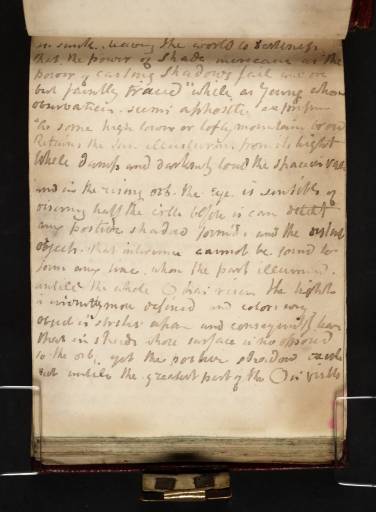Joseph Mallord William Turner Inscription by Turner: Notes on Sunlight c.1809
Joseph Mallord William Turner,
Inscription by Turner: Notes on Sunlight
c.1809
Joseph Mallord William Turner 1775–1851
Folio 87 Verso:
Inscription by Turner: Notes on Sunlight circa 1809
D07503
Turner Bequest CVIII 87a
Turner Bequest CVIII 87a
Pen and ink on white wove paper, 115 x 88 mm
Part watermark ‘J What | 180’
Inscribed by Turner in ink (see main catalogue entry)
Part watermark ‘J What | 180’
Inscribed by Turner in ink (see main catalogue entry)
Accepted by the nation as part of the Turner Bequest 1856
References
1909
A.J. Finberg, A Complete Inventory of the Drawings of the Turner Bequest, London 1909, vol.I, p.291, CVIII 87a, as ‘Notes’.
1969
John Gage, Colour in Turner: Poetry and Truth, London 1969, pp.178, 252 note 217.
1992
Maurice Davies, Turner as Professor: The Artist and Linear Perspective, exhibition catalogue, Tate Gallery, London 1992, pp.51, 108 note 85.
1994
Maurice William Davies, ‘J.M.W. Turner’s Approach to Perspective in his Royal Academy Lectures of 1811’, unpublished Ph.D thesis, Courtauld Institute of Art, London 1994, p.289.
The whole page is taken up with the following notes:
[?so] small, leaving the world to darkness | that the power of shade increases as the | power of casting shadows fail [?and are] | but faintly traced while as Young whose | observation seems apposite expresses
“As some high tower or lofty mountain brow
Retains the sun illustrious from its hight
While damp and darkness [?cloud] the spacious vale
Retains the sun illustrious from its hight
While damp and darkness [?cloud] the spacious vale
and in the rising orb the eye is sensible of | discerning half the circle before it can detect | any positive shadow form’d, and the distant | objects that intervene cannot be found to | form any lines upon the part illumin’d | untill the whole O has risen the hight | is evidently more defined and colors any | object it strikes upon and consequently leave | that in shadow whose surface is no opposed | to the orb, yet the positive shadow casts | not untill the greatest part of the O is visible
This passage follows on from folio 88 verso (D07505) and continues on the recto of the present leaf (D07502). It is part of a sequence beginning on folio 91 verso (D07511), and running back to folio 82 verso (D07493). John Gage has discussed these provisional notes (not developed in the perspective lectures) as an example of Turner’s close observation of natural phenomena,1 in this case the question of sunlight travelling in parallel lines or otherwise, responding to a chapter of The Art of Painting by Gérard de Lairesse (1640–1711), in the English translation by John Frederick Frisch (London 1738 and later editions).2 See under D07511 for a discussion of Lairesse’s text. Maurice Davies has registered Turner’s notes as ‘on light and shadow’, as part of a longer sequence running back to folio 72 verso (D07473).3
Turner’s first line may be an echo of Thomas Gray’s Elegy Written in a Country Churchyard (lines 3–4): ‘The ploughman homeward plods his weary way, | And leaves the world to darkness and to me’. He then quotes from memory or adapts a passage near the end of ‘Night II’ of The Complaint, by Edward Young:
As some tall tower, or lofty mountain’s brow,
Detains the sun, illustrious, from its height,
While rising vapours, and descending shades,
With damps and darkness, drown the spacious vale
Detains the sun, illustrious, from its height,
While rising vapours, and descending shades,
With damps and darkness, drown the spacious vale
This is in keeping with his sensitive response to poetic descriptions of particular times of day, light or weather, reflected in his established practice of quoting suitable passages from, for example, John Milton and James Thomson in the entries for his Royal Academy exhibits to illuminate the meanings of his landscapes.4 (See the sketchbook Introduction for the various passages of Turner’s own poetry in the present book.)
Matthew Imms
June 2008
How to cite
Matthew Imms, ‘Inscription by Turner: Notes on Sunlight c.1809 by Joseph Mallord William Turner’, catalogue entry, June 2008, in David Blayney Brown (ed.), J.M.W. Turner: Sketchbooks, Drawings and Watercolours, Tate Research Publication, December 2012, https://www

